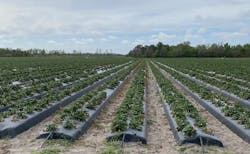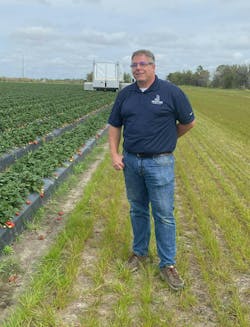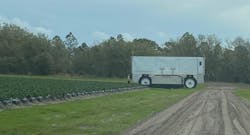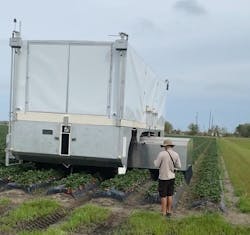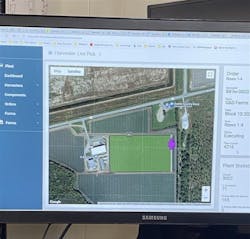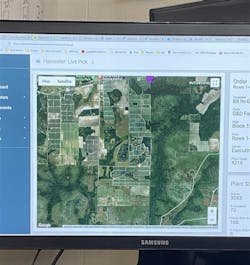Picking Precision: Advantages of Robotics in Agriculture
With an ever-increasing global population, the agricultural community can no longer rely on human-only cultivation and harvesting for the current and future demand for food. Machine harvesting has been commonplace in grain-based fields for decades, but the challenges of picking fruits and vegetables have their own unique set of challenges.
“The project is continuously driven because of the difficulty of finding harvesting labor,” said Bob Pitzer, co-founder, CTO and engineering manager at Harvest CROO Robotics LLC. “Strawberries are one of the most labor-intensive crops, and if an automated way of harvesting them is not deployed soon, the berries will go back to being a luxury item unavailable to the majority of people.”
To address these challenges, Harvest CROO is transforming agriculture with technological advancements, cultivating the way for increased efficiency and productivity. Along with funding from the strawberry growers in central Florida, the company has developed a 12.5-ton connected, integrated, automated robotic strawberry harvester. This I had to see, so I took a ride out to a Wish Farms grower, G&D Farms in Duette, Fla. There, Pitzer and his team were running tests on the pre-production robotic picker and graciously showed me around.
READ MORE: Technology is Key to the Future of Farming
An IOT Ag Solution in the (Literal) Field
In the expanse of commercial and organic strawberry fields, controlled factory automation met an expansive mobile system. “The whole harvester is an IOT device,” said Pitzer, as he pointed to the slow-moving large rectangular vehicle off in the distance. Unlike traditional six-axis robots confined to specific tasks in controlled environments, the robotic harvester faces the complexities of delicate strawberry picking amidst the vibrations of a moving platform.
“The harvester needs to be fairly nimble to navigate existing fields,” Pitzer said, explaining that the farms aim to use their land efficiently by maximizing plant coverage; therefore, a large machine must operate within the confines of the existing truck pathways on the farm for navigation. “The harvester is four-wheel steer/drive to accomplish this and can spin on its wheelbase of 20 feet,” he said.
Inside the harvester, on the upper deck, strawberries that have been selected using proprietary technology and then robotically picked are conveyed up, sanitized and kept at a cool temperature for food safety and improved shelf life. (Credit: Sharon Spielman)
Designed with efficiency and maintenance in mind, the machine operates on a diesel-electric setup akin to a train locomotive, with a large generator powering electrical motors for smoother, maintenance-free operation, Pitzer explained as we walked alongside the huge harvester. He said that for a machine intended to run 24/7, the choice of electricity over hydraulics ensures reliability and cost-effectiveness in the long run.
The heart of the robotic picker lies in its meticulously designed control system. Pitzer explained that the air cylinders are used to neutrally float the pick deck, which supports the weight of the 16 robotic arms and keeps them durable and robust. The balancing systems, including spring setups on the robots and mechanical adjustments, ensure precise positioning and reduce strain on the servo motors. Pitzer says that by incorporating spring balancing and other mechanisms, the machine optimizes energy usage and reduces heat buildup in the electrical components.
The machine’s cooling system, which is reminiscent of refrigerator trucks, plays an important role in ensuring the freshness and cleanliness of the harvested strawberries, Pitzer says, noting that the harvester can hold up to 10,000 lb. of picked berries. A chiller system cools the water circulating through the tanks, which is necessary for sterilizing the berries and maintaining food safety standards. Unlike human labor, robots eliminate the risk of disease transfer and ensure a higher level of cleanliness by using quick disconnect parts that can be easily replaced and sanitized. This meticulous approach to handling berries not only reduces the chances of contamination but also spoilage.
The integration of advanced technologies like sensors and AI enhances the performance of these robots in selective harvesting, where delicate fruits are carefully picked without damaging surrounding produce.
READ MORE: Automate 2024 Preview: Robotics, Vision, Artificial Intelligence, Motion Control
Robotic Pickers: From Concept to Fruition
The journey of conceptualizing and implementing these robotic pickers dates to 2013, Pitzer said, when the initial experiments were conducted. Harvest CROO, a sister company to the farm, spearheaded this endeavor funded by major players in the strawberry industry. Through years of research and development, the team has secured multiple patents for their innovative systems, establishing a new standard in agricultural automation. The robots’ ability to scan plants, create 3D models and navigate precise paths for picking displays the level of technological sophistication that has been achieved in this field.
The data collection and analysis capabilities of these robotic pickers are vast with servers storing terabytes of information for real-time monitoring and decision making, according to Pitzer. The software integrated into the system enables farmers to track harvest progress, analyze crop performance and optimize harvesting strategies. Utilizing cutting-edge technologies like artificial intelligence (AI) and cloud computing, these robotic pickers have transformed traditional farming practices by enhancing efficiency precision and data-driven insights.
The harvester uses LiDAR technology and differential global positioning systems (DGPS) to do all its navigation. “The GPS provides the waypoints and plant locations and the LiDAR detects the anomalies and farm accessories to be able to navigate the harvester around autonomously,” Pitzer explained. “It’s not fast, so collision avoidance and the pre-configured farm make navigation relatively simple compared to autonomous cars, etc.,” he said.
Using advanced cameras, LiDAR and electric actuators, the robotic harvester can scan, inspect and pick strawberries autonomously. As for the integration of sensors, AI and other technologies used to detect and harvest the ripe berries, Pitzer says the robots and inspection systems also use limited AI and machine vision to pick and inspect the berries, all with RGB cameras. “The robots are positioned to look for the berries in a confined envelope to make the berries easier to find and provide conservation of motion for doing the pick-and-place for pulling the berries off the plants in an economical fashion,” he said. “Ripeness is done in a proprietary way, and all the hardware is custom to handle the delicate fruit.”
Over an 11-year span, the project has seen technological advancements and strategic partnerships with manufacturers, inching closer to producing harvesters at a viable rate, Pitzer said. By leveraging a combination of Intel Mobius and NVIDIA processors for vision processing and partnering with Festo for component fabrication, the project integrates cutting-edge technology and modular design principles to streamline production processes. “[The system] is cross correlating two cameras to tell you the depth of the strawberry,”—even with all the green that surrounds the plant, measuring the fruit bed within a couple of millimeters, Pitzer said. “We don’t damage [the plant]…you couldn’t do that on a single-processor system [before],” noting that much more powerful processors are being developed every day.
Credit: Harvest CROO
Cultivating a Business Plan, Nurturing the Future
To deploy thousands of harvesters effectively and work with farms that are accustomed to traditional labor practices, a strong infrastructure is necessary, Pitzer said. This collaborative effort not only ensures scalability but the goal is to foster partnerships with industry stakeholders (think John Deere and Caterpillar). Pitzer adds that the business model of leasing the machines to farms offers a sustainable approach to introducing robotic harvesters.
The machine is in its testing and refinement phase, using data collection and feedback to improve performance. The harvester knows all the plant positions, so that gives it the ability to collect information about individual plants, Pitzer explains. “Many metrics are collected related to berries on the plant and any forecast information that can be accomplished like counting blooms or counting unripe berries. It is a large data collection machine,” he said. “This information is constantly analyzed to improve robot performance and is going to be used in the near future for reinforcement training of the robot movement to improve.”
As for how Pitzer foresees the role of robotics technology evolving in the agricultural industry: Manipulating robotics will first impact fresh fruits and vegetables. “Most people don’t realize that 90% of what they pull out of the produce section of the grocery is still hand-picked,” he said.
Some crops make more sense than others do initially because of the way they have to be harvested, Pitzer explained. “Strawberry plants are picked ~40 times during a growing season and account for 50% to 60% of the overall farm cost for growing the strawberries,” he said. “It’s a very expensive crop to harvest, therefore the cost of the automation can be justified. As this technology matures, it will reduce in cost and make sense to migrate to other crops.”
From Challenging Competition to Agricultural Problem-Solving
During a visit to G&D Farm in Duette, Fla., Bob Pitzer, co-founder, CTO and engineering manager at Harvest CROO Robotics, spoke of the impact that the FIRST Robotics Challenge has had on endeavors such as the robotic strawberry harvester that the company and the strawberry industry has been designing and manufacturing for more than a decade. The competition has helped foster young talent in engineering and innovation, he said.
Originating in 1994, the FIRST Challenge involves teams constructing large robots to compete in various tasks. Behind the scenes, mentors and professionals focus on integrating lights, wires, software and infrastructure to ensure smooth event operations, allowing students to highlight their robot designs effectively.
Pitzer talked about the pivotal development that surfaced in 2009 when advancements were made to enhance robot capabilities through Wi-Fi control systems, challenging conventional beliefs about real-time control using Ethernet and Wi-Fi. Collaboration with industry leaders like National Instruments and Cisco drove the integration of networked robots, he said, setting the stage for students to engage in practical engineering tasks. The growth of the first robotics challenge, from 600 teams in 2006 to more than 8,000 teams today, underlines the impact of technology and mentorship in nurturing the next generation of innovative engineers and problem-solvers.
About the Author
Sharon Spielman
Technical Editor, Machine Design
As Machine Design’s technical editor, Sharon Spielman produces content for the brand’s focus audience—design and multidisciplinary engineers. Her beat includes 3D printing/CAD; mechanical and motion systems, with an emphasis on pneumatics and linear motion; automation; robotics; and CNC machining.
Spielman has more than three decades of experience as a writer and editor for a range of B2B brands, including those that cover machine design; electrical design and manufacturing; interconnection technology; food and beverage manufacturing; process heating and cooling; finishing; and package converting.
Email: [email protected]
LinkedIn: @sharonspielman
Facebook: Machine Design
YouTube: @MachineDesign-EBM
